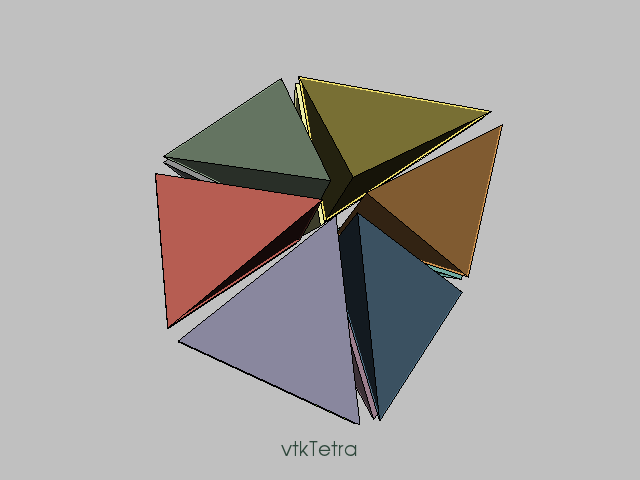CellTypeSource
Repository source: CellTypeSource
Description¶
This example uses vtkCellTypeSource to generate a vtkUnstructuredGrid. If a cell does not fill a rectangular area or volume, then multiple cells will be generated. For example, a vtkTetra requires 12 cells to fill a cube. A vtkTriangle requires two cells to fill a square. vtkCellTypeSource generates a uniform set of coordinates. The example perturbs those coordinates to illustrate the results of the vtkTessellatorFilter. Also, each cell is passed through vtkShrinkFilter to help identify the cells. Each generated cell also has a unique color.
The example takes an optional argument, a vtkCell name.
For example, to generate vtkTriangles, run
CellTypeSource [vtkTriangle](https://www.vtk.org/doc/nightly/html/classvtkTriangle.html)
Other languages
See (Cxx), (PythonicAPI)
Question
If you have a question about this example, please use the VTK Discourse Forum
Code¶
CellTypeSource.py
# !/usr/bin/env python
# -*- coding: utf-8 -*-
# noinspection PyUnresolvedReferences
import vtkmodules.vtkInteractionStyle
# noinspection PyUnresolvedReferences
import vtkmodules.vtkRenderingFreeType
# noinspection PyUnresolvedReferences
import vtkmodules.vtkRenderingOpenGL2
from vtkmodules.vtkCommonColor import (
vtkColorSeries,
vtkNamedColors
)
from vtkmodules.vtkCommonCore import (
vtkIntArray,
vtkLookupTable,
vtkMinimalStandardRandomSequence,
vtkPoints
)
from vtkmodules.vtkCommonDataModel import (
VTK_CUBIC_LINE,
VTK_HEXAHEDRON,
VTK_LINE,
VTK_PYRAMID,
VTK_QUAD,
VTK_QUADRATIC_EDGE,
VTK_QUADRATIC_HEXAHEDRON,
VTK_QUADRATIC_PYRAMID,
VTK_QUADRATIC_QUAD,
VTK_QUADRATIC_TETRA,
VTK_QUADRATIC_TRIANGLE,
VTK_QUADRATIC_WEDGE,
VTK_TETRA,
VTK_TRIANGLE,
VTK_WEDGE,
vtkCellTypes
)
from vtkmodules.vtkFiltersGeneral import (
vtkShrinkFilter,
vtkTessellatorFilter
)
from vtkmodules.vtkFiltersSources import vtkCellTypeSource
from vtkmodules.vtkRenderingCore import (
vtkActor,
vtkActor2D,
vtkDataSetMapper,
vtkRenderWindow,
vtkRenderWindowInteractor,
vtkRenderer,
vtkTextMapper,
vtkTextProperty
)
def main():
cellName = get_program_parameters()
# Store the cell class names in a dictionary.
cellMap = dict()
cellMap[vtkCellTypes.GetClassNameFromTypeId(VTK_LINE)] = VTK_LINE
cellMap[vtkCellTypes.GetClassNameFromTypeId(VTK_QUADRATIC_EDGE)] = VTK_QUADRATIC_EDGE
cellMap[vtkCellTypes.GetClassNameFromTypeId(VTK_CUBIC_LINE)] = VTK_CUBIC_LINE
cellMap[vtkCellTypes.GetClassNameFromTypeId(VTK_TRIANGLE)] = VTK_TRIANGLE
cellMap[vtkCellTypes.GetClassNameFromTypeId(VTK_QUADRATIC_TRIANGLE)] = VTK_QUADRATIC_TRIANGLE
cellMap[vtkCellTypes.GetClassNameFromTypeId(VTK_QUAD)] = VTK_QUAD
cellMap[vtkCellTypes.GetClassNameFromTypeId(VTK_QUADRATIC_QUAD)] = VTK_QUADRATIC_QUAD
cellMap[vtkCellTypes.GetClassNameFromTypeId(VTK_TETRA)] = VTK_TETRA
cellMap[vtkCellTypes.GetClassNameFromTypeId(VTK_HEXAHEDRON)] = VTK_HEXAHEDRON
cellMap[vtkCellTypes.GetClassNameFromTypeId(VTK_WEDGE)] = VTK_WEDGE
cellMap[vtkCellTypes.GetClassNameFromTypeId(VTK_PYRAMID)] = VTK_PYRAMID
cellMap[vtkCellTypes.GetClassNameFromTypeId(VTK_QUADRATIC_WEDGE)] = VTK_QUADRATIC_WEDGE
cellMap[vtkCellTypes.GetClassNameFromTypeId(VTK_QUADRATIC_PYRAMID)] = VTK_QUADRATIC_PYRAMID
cellMap[vtkCellTypes.GetClassNameFromTypeId(VTK_QUADRATIC_HEXAHEDRON)] = VTK_QUADRATIC_HEXAHEDRON
cellMap[vtkCellTypes.GetClassNameFromTypeId(VTK_QUADRATIC_TETRA)] = VTK_QUADRATIC_TETRA
if cellName not in cellMap:
print('Cell type ', cellName, ' is not supported.')
return
source = vtkCellTypeSource()
source.SetCellType(cellMap[cellName])
source.Update()
print('Cell: ', cellName)
originalPoints = source.GetOutput().GetPoints()
points = vtkPoints()
points.SetNumberOfPoints(source.GetOutput().GetNumberOfPoints())
rng = vtkMinimalStandardRandomSequence()
rng.SetSeed(5070) # for testing
for i in range(0, points.GetNumberOfPoints()):
perturbation = [0.0] * 3
for j in range(0, 3):
rng.Next()
perturbation[j] = rng.GetRangeValue(-0.1, 0.1)
currentPoint = [0.0] * 3
originalPoints.GetPoint(i, currentPoint)
points.SetPoint(i, currentPoint[0] + perturbation[0],
currentPoint[1] + perturbation[1],
currentPoint[2] + perturbation[2])
source.GetOutput().SetPoints(points)
numCells = source.GetOutput().GetNumberOfCells()
print('Number of cells: ', numCells)
idArray = vtkIntArray()
idArray.SetNumberOfTuples(numCells)
for i in range(0, numCells):
idArray.InsertTuple1(i, i + 1)
idArray.SetName('Ids')
source.GetOutput().GetCellData().AddArray(idArray)
source.GetOutput().GetCellData().SetActiveScalars('Ids')
shrink = vtkShrinkFilter()
shrink.SetInputConnection(source.GetOutputPort())
shrink.SetShrinkFactor(.8)
tessellate = vtkTessellatorFilter()
tessellate.SetInputConnection(shrink.GetOutputPort())
tessellate.SetMaximumNumberOfSubdivisions(3)
# Create a lookup table to map cell data to colors.
lut = vtkLookupTable()
colorSeries = vtkColorSeries()
seriesEnum = colorSeries.BREWER_QUALITATIVE_SET3
colorSeries.SetColorScheme(seriesEnum)
colorSeries.BuildLookupTable(lut, colorSeries.ORDINAL)
# Fill in a few known colors, the rest will be generated if needed.
colors = vtkNamedColors()
# Create a mapper and actor.
mapper = vtkDataSetMapper()
mapper.SetInputConnection(source.GetOutputPort())
mapper.SetInputConnection(shrink.GetOutputPort())
mapper.SetScalarRange(0, numCells + 1)
mapper.SetLookupTable(lut)
mapper.SetScalarModeToUseCellData()
mapper.SetResolveCoincidentTopologyToPolygonOffset()
if (source.GetCellType() == VTK_QUADRATIC_PYRAMID or
source.GetCellType() == VTK_QUADRATIC_WEDGE):
mapper.SetInputConnection(shrink.GetOutputPort())
else:
mapper.SetInputConnection(tessellate.GetOutputPort())
actor = vtkActor()
actor.SetMapper(mapper)
actor.GetProperty().EdgeVisibilityOn()
# actor.GetProperty().SetLineWidth(3)
textProperty = vtkTextProperty()
textProperty.SetFontSize(20)
textProperty.SetJustificationToCentered()
textProperty.SetColor(colors.GetColor3d('Lamp_Black'))
textMapper = vtkTextMapper()
textMapper.SetInput(cellName)
textMapper.SetTextProperty(textProperty)
textActor = vtkActor2D()
textActor.SetMapper(textMapper)
textActor.SetPosition(320, 20)
# Create a renderer, render window, and interactor.
renderer = vtkRenderer()
renderWindow = vtkRenderWindow()
renderWindow.SetWindowName('CellTypeSource')
renderWindow.AddRenderer(renderer)
renderWindowInteractor = vtkRenderWindowInteractor()
renderWindowInteractor.SetRenderWindow(renderWindow)
# Add the actors to the scene.
renderer.AddViewProp(textActor)
renderer.AddActor(actor)
renderer.SetBackground(colors.GetColor3d('Silver'))
renderer.ResetCamera()
renderer.GetActiveCamera().Azimuth(30)
renderer.GetActiveCamera().Elevation(30)
renderer.ResetCameraClippingRange()
# Render and interact.
renderWindow.SetSize(640, 480)
renderWindow.Render()
renderWindowInteractor.Start()
def get_program_parameters():
import argparse
description = 'Cell Type Source.'
epilogue = '''
You can supply an optional argument consisting of a vtkCell name e.g: vtkTriangle.
The default is vtkTetra.
'''
parser = argparse.ArgumentParser(description=description, epilog=epilogue,
formatter_class=argparse.RawDescriptionHelpFormatter)
parser.add_argument('cell_name', nargs='?', const='vtkTetra', default='vtkTetra', type=str, help='The cell name.')
args = parser.parse_args()
return args.cell_name
if __name__ == '__main__':
main()
